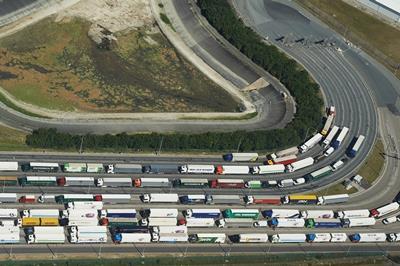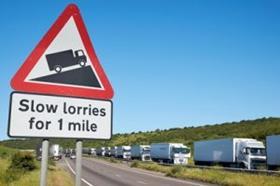
Given the severity of the situation international operators face in Calais, risk management firm Spherical International has conducted an assessment of the region, and supplied its findings to Motortransport.co.uk readers.
Risk of violence in Calais
Ask anyone involved in UK haulage what is affecting their international capability today and most will respond that is it the issues at Calais port and its ongoing deficit in ability to cope with the flow of traffic, specifically HGV’s. The recent changes disruptions and strikes have caused utter chaos and uproar among the UK haulage industry and many industry officials are warning of forthcoming food and produce shortages.
Ask any haulier what their next concern affecting Calais port and nearly all will tell you that it is the ongoing issues with clandestine illegal entrants attempting to board their HGV’s to covertly cross the channel to the UK and what is perceived by many as the promised land. I set out to see the situation for myself and visited Calais for 48 hours to experience the reality.
Fact Finding
Having conducted a bit of research into this issue I thought I was equipped with a rough idea of what to expect, in actual fact the realities were far worse. Accompanied by a colleague, we arrived in Calais and conducted a familiarisation of the area and drove to the renowned areas such as that known as “Diesel Alley” and the formidably named “jungle”. The Jungle is an area of scrub land situated near to the main arterial road into the port. Images of multinational refugees co-habiting in a mass of tents and self-made shacks have been well publicised, however you cannot truly appreciated it’s depravity until you have experienced it first-hand. While portable toilets have been provided at the main entrance, these are by no means sufficient for the estimated 3000 people occupying this area and people are forced to use the immediate area as their toilet, defecating in close proximity to their makeshift homes. Internal conflict is common, with gang fights a regular occurrence. Basic human rights neglected, risk of disease heightened and safety compromised.

Assessing the Threat
Clearly, their situation is desperate, many have travelled thousands of miles through some of the world’s most dangerous counties, negotiating their way through gang crime, genocide, drug smugglers, human traffic gangs, sex crime kingpins and war torn countries where life is worthless. So when they make it to Calais do the measures that are currently in place really deter them in any way? No of course not, their intent to make it those last few miles is very high, their determination has been tested a dozen times already and there is little that will quell their enthusiasm to make the last journey. Especially when the consequences of being caught doing so have little to no impact on them or their intent.
While they may not have the sophisticated means to break into and enter vehicles, the capability to adapt and overcome problems is unparalleled, their use of simple tools and knives is common place. Unfortunately, in recent weeks these have been used to attack hauliers who have either prevented them from entering the vehicles or while searching for them. With little left to lose and virtually no consequences there is little to deter them from taking very drastic action.
Night Fall
Around two hours before night fall a trickle of concealed illegal entrants, now known as clandestine’s are seen walking from the Jungle down the long road towards Diesel Alley, this area is where the majority of HGV’s and hauliers rest up before their ferry or train is due to depart. Dotted along this road are a series of fuelling stations, some staffed and some self-service. HGV’s are dotted all over the area, parked up ready to move off. Their drivers either sleeping in their cabs or in one of the truck stop rest areas.
The clandestine’s walk in a long slow stream down Diesel Alley paralleling the train line. As night falls, the trickle of clandestine’s leaving the Jungle increases into a deluge which forms a near constant stream stretching from one end of Diesel Alley to another some 1.5 miles away. Periodically they will peel off from the main line and into the turnings where the HGV’s are parked up and slip into the shadows where they can begin to explore opportunities to board HGV’s and their trailers. The sheer volume of people trying every HGV is utterly unbelievable and the true problem is now fully clear; hundreds of people clambering for their final safe hiding place.

A Haulier’s View
Whilst in Calais we spoke to a number of British, Irish and other European drivers, all of them agreed that the problem was now at epidemic levels with little hope of a sustainable resolution. Many of these drivers are not averse to the risks that come with being a long haul driver. One British driver who had been in the international freight industry for over 20 years told me that the issues with clandestine’s were the worst he’d seen anywhere on the European continent. He admitted that hauliers had to be robust and generally didn’t get phased by a few people trying to stow away in their HGV’s. He went on to say that the issues in Calais were like nothing that had been seen before and the risks posed to drivers were severe. When I asked what he was most concerned about he responded “dying”. I was a little shocked I was expecting fines or pressure from the freight company. I asked him to expand on this. He explained that drivers were now being attacked by clandestine’s, last week one was stabbed. The feeling is that it’s only a matter of time before a haulier is killed.
The Real Risks
The layers of risk posed by this situation are numerous, the primary risks concerning the driver’s safety, the damage to the trailers and their contents are very much at the coal face of this problem. But what about the deeper risks.
So what if drivers start to get attacked regularly? And what if someone is killed? Well the warning signs are there. For anyone who has taken the time to speak to the drivers and seen the situation at face value knows that it is only a matter of time before this escalates further. Are the driver’s best interest being cared for? Even though they are in France their employer’s duty obligation should continue, not only from a moralistic point of view but for those UK based companies from the Health and Safety at Work Act 1974, failure to act and do all that is reasonably practicable is arguably a neglect on the employer’s behalf.
At what point do they stop working and refuse to transit the high risk area of Calais? If they do then what? Will the haulage companies move to Dunkirk some 45 minutes east of Calais? Essentially, so will the problem. A few more miles will make little or no difference to clandestine illegal entrants who have risked their lives to get this far.

UK government solution
Approximately 35,000 illegal immigrants were discovered trying to breach security measures at Calais in the last six months so what is being done? The UK government have provided £12m worth of financial aid to assist the French Government to secure Calais Port and the Eurotunnel at Coquelles. Around £6m has already been spent on some formidable fencing around and leading up to the port entrance. The double layered anti-climb fence that is over 10 feet tall with razor wire atop certainly makes the prospect of climbing over somewhat less appealing to most. However, the clandestine illegal entrants that pose the threat are not most people. Their intent and capability will undoubtedly breach these measures, this was witnessed first-hand when I watched two men climb over the newly erected anti-climb fence some 20–30 metres from the port authorities’ entrance and go unchallenged into the controlled zone.
The remainder of the funds have been pledged to upgrade the technical security at Calais Port, to provide a secure parking area for 230 HGVs going some way to elevating the issue from the 5000 plus that pass through each week and an amount has been allocated for fencing at the Eurotunnel site.
These solution will help to reduce the clandestine’s ability to reach the HGV’s and are one layer of mitigation that is required to provide a real solution to protecting the hauliers, their HGV’s, trailers and loads, the haulage and freight companies and UK economy. Work is being undertaken on the wider measures concerning the issues, the UK pledging 90 officers to assist in investigating and assisting in preventing the gang masters who facilitate the immigrant’s perilous journeys. But what is being done closer to the driver HGV and load?
Having had the opportunity to see all of this first hand, to conduct an assessment of the situation as it is and understand how future measures will affect the haulier’s vulnerability, it is clear that they are left exposed with little or nothing being done for them directly. There are solutions to assist the industry, hauliers, suppliers and customers, solutions that can reduce damage, likelihood of injury, litigation and fines while complimenting the work being undertaken by the UK and French authorities.
This was written by Nathan Monshin, director, international risk, at Spherical International.
Spherical International are a UK based security risk management company that offer a bespoke and tailored service and can be found @SphericalRisk or 0203 693 3837.











